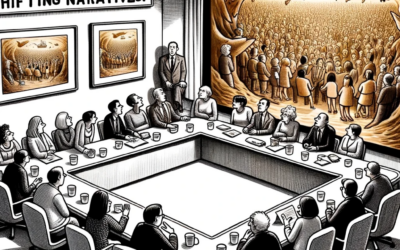Your eye translates signals via rods and cones to the optic nerve. In general, there are far more rods on the periphery of your retina and a much higher concentration of cones in the central fovea. Rods help us detect motion and see in the dark. Cones allow us to see color and have high-resolution vision during the day. So why is this eye information important, unless maybe you’re an optometrist?
In leadership, we often discuss vision and blind spots. We focus a lot on what we see and what we don’t. We don’t often consider, though, how we see.
In the central fovea, we’re able to produce high-resolution vision because there’s a one-to-one ratio of cones and ganglion cells (which, together, form the optic nerve). There is little-to-no loss in signal.
On the periphery of the retina, the ratio of photo-receptors (rods and cones) is much higher (closer to 100:1). The signal is far more diffuse. Our peripheral vision is low resolution as a result, but it’s good enough to perceive moving objects that may pose threats to our safety.
Peripheral Vision Exercise
Hold your left hand up just inside your field of vision. Raise two fingers. What do you see? If you’re not moving your hand or fingers, you’re not likely to see much of anything. Now wiggle your fingers. That will catch your eye’s attention. Still, the image won’t be sharp unless you turn your head toward it.
We’re fortunate to have both high-resolution vision (courtesy of our cones) and peripheral/night vision (thanks to the rods). We’re able to accomplish many different tasks as a result and avoid many threats. We are, however, still susceptible to blind spots.
Blind Spot Exercise
Blind spots, interestingly, 0ccur when we get very close to the object we’re viewing. Our blind spots are right in front of us, just slightly off-center. Here’s an exercise to do if you want to “see” your blind spot.
Leadership Vision
Great leaders know where their blind spots are, present a high-resolution vision of the organization’s future, and are mindful of activity happening on the periphery. Great leaders encourage diversity of thought and skills so that they can see and overcome their own blind spots. They use the high-resolution vision as a way to bring team members back into alignment. And they check to make sure that moving objects–be they customers, competitors, markets, or employees–don’t pose a significant threat.
Great leaders strike a balance when it comes to using peripheral vision vs. focusing on the central vision of the organization. Most of the leader’s time should be spent looking straight ahead. Too much focus on the periphery can result in whiplash for the organization. The organization may struggle to meet its purpose–or lose sight of that purpose as it tries to adjust to what everyone else is doing. Then again, leaders and their organizations can be blindsided if they completely ignore what’s going on around them. Leaders must examine all rapidly-approaching objects, and encourage team members to look for and report such happenings, but beware of over-reacting.
Knowing how you see can help you know what to look at and when.



